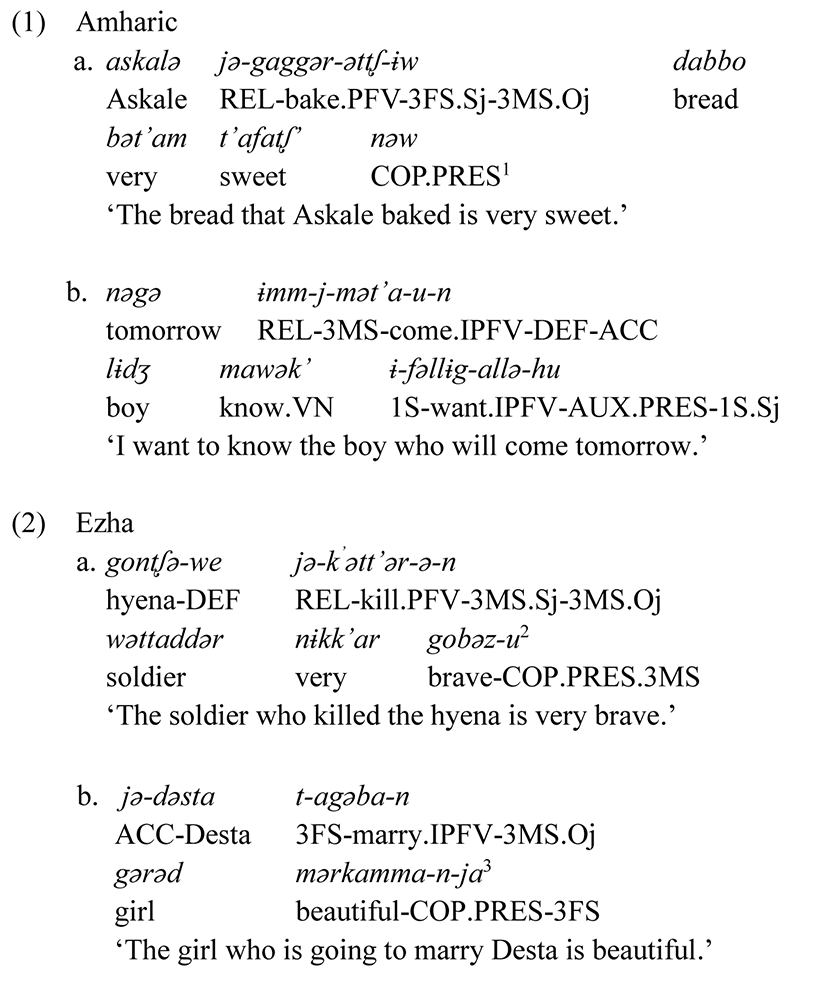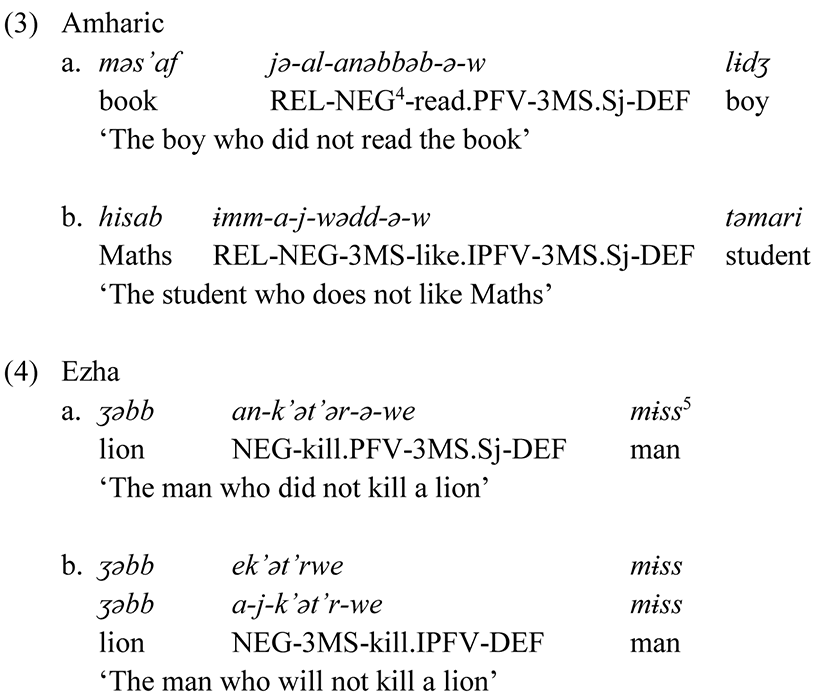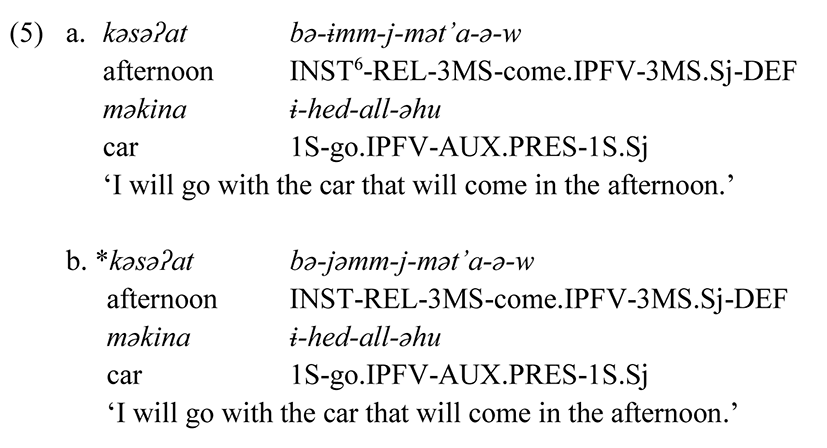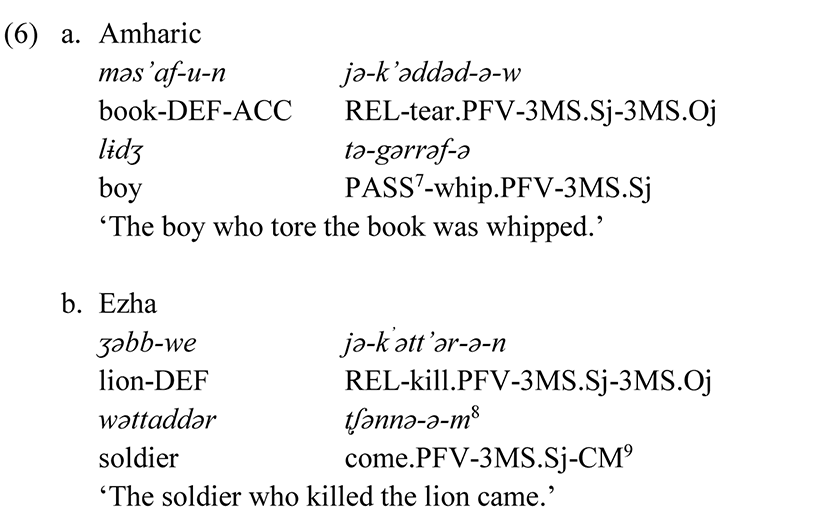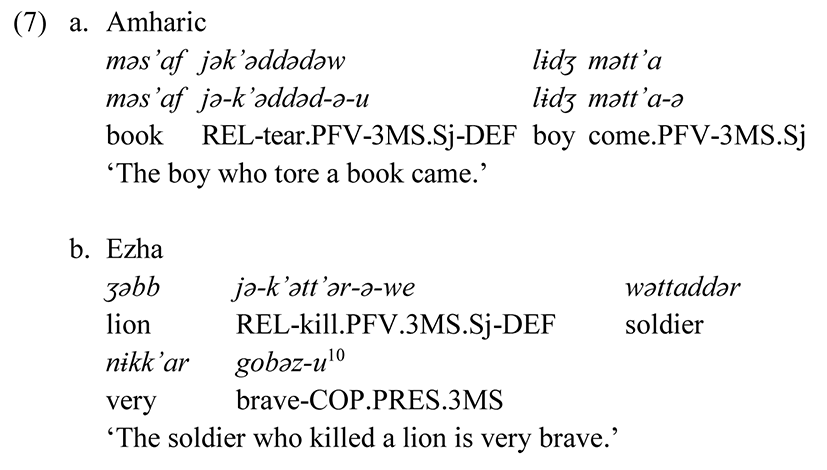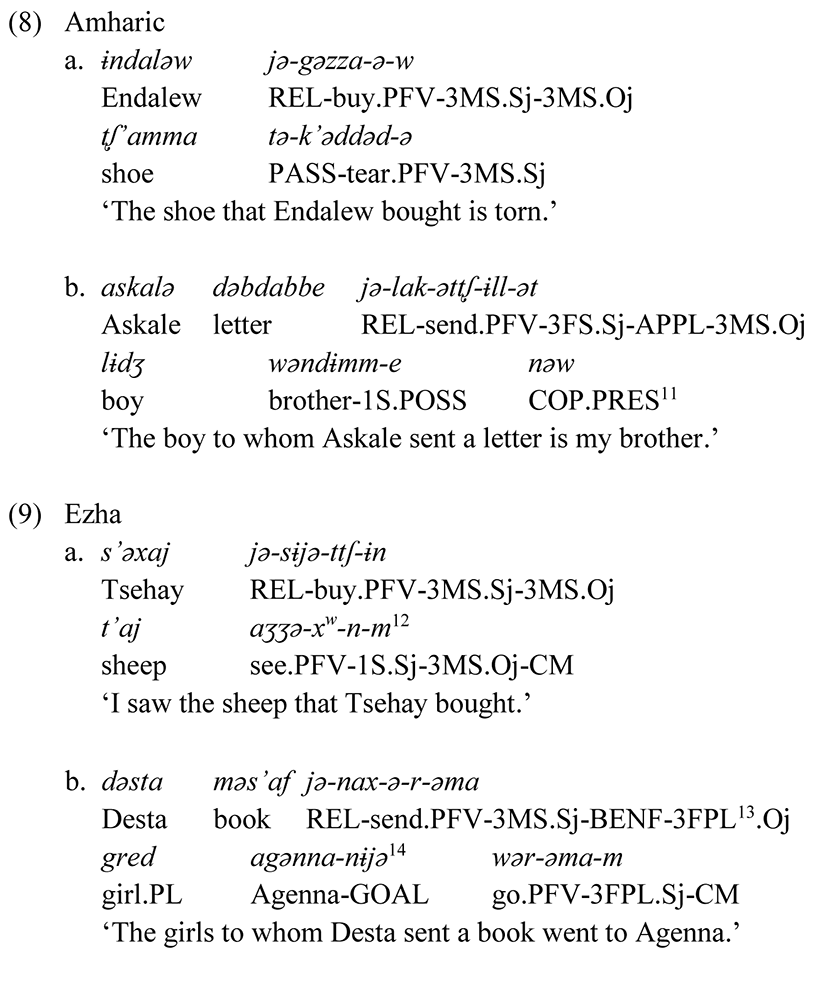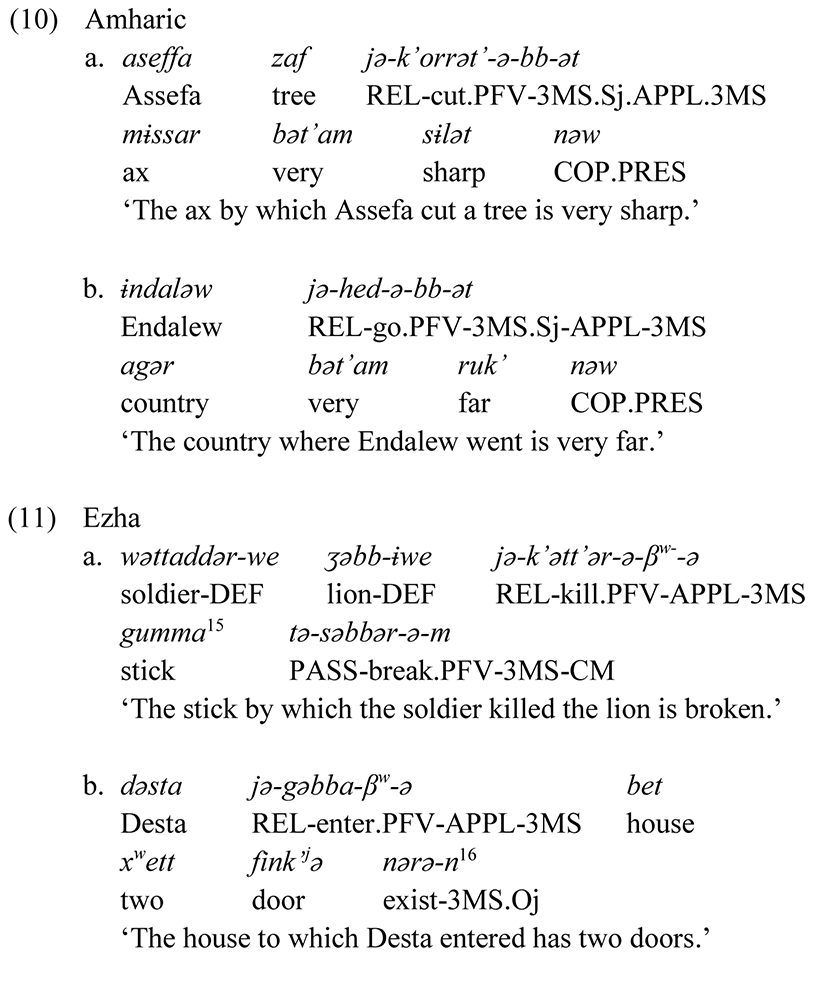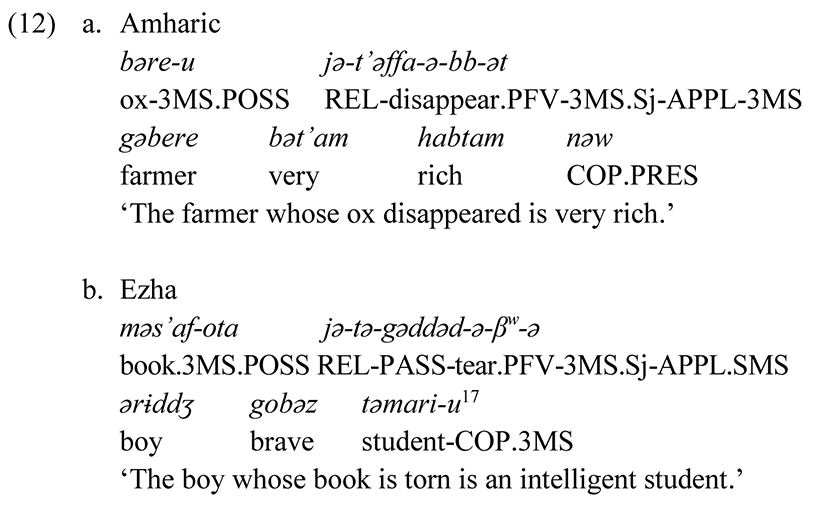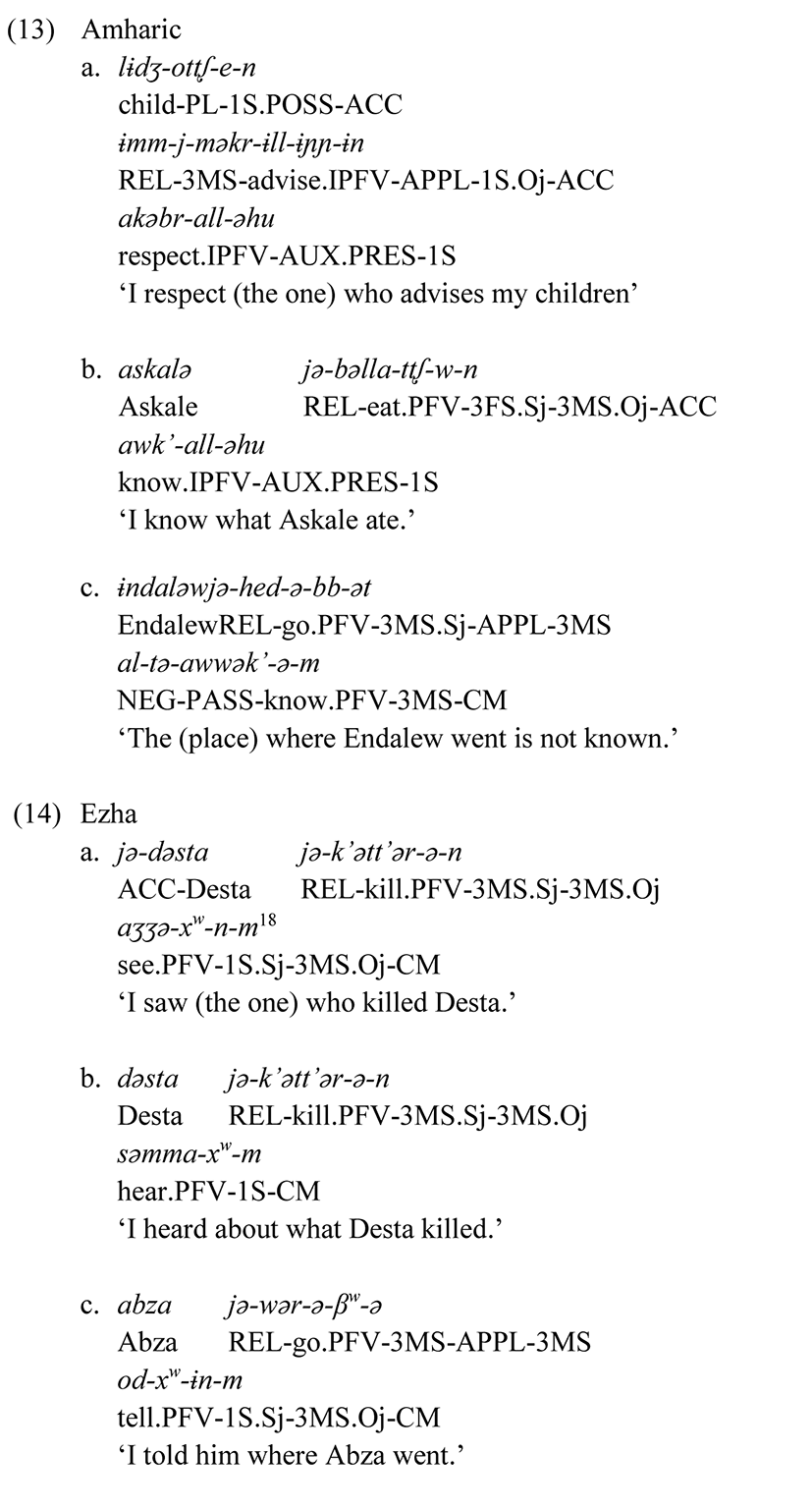1. Introduction
Both Amharic and Ezha belong to the South Ethio-Semitic language sub-phylum under the Ethio-Semitic language phylum. Within the South Ethio-Semitic, Amharic assumes the Transversal South Ethio-Semitic family, while Ezha belongs to the Outer South Ethio-Semitic sub-class (Hetzron 1977).
The Amharic language is natively spoken in the Amhara region of the country (Ethiopia), i.e. Gojjam, Gonder, Wello and Shewa. Besides, it is predominantly spoken in Addis Ababa, the country’s capital, in addition to other regions where the language is spoken as a second language by non-Amharas and as a native language by Amhara migrants. Note also that Amharic serves as a working language for the federal government of Ethiopia and as a lingua franca in virtually all parts of the country. The number of its native speakers counts approximately 17.5 million plus, and roughly other 5 million plus people speak it as a second language (Grimes 2003, Meyer 2011).
On the other hand, Ezha is typically spoken in and around the Agenna town within the Gurage administrative zone of the Southern Nations, Nationalities, and Peoples Regional State (SNNPR) of Ethiopia. The area where Ezha is spoken is bordered to the north-east by Muher, to the south-west by Chaha and to the east by Gumer (Assefa 2014).
This article provides a descriptive account of relative clauses in the two languagesː Amharic and Ezha. Relativization phenomena in these languages have been presented by way of making typological comparisons. According to Payne (1997), a relative clause is a dependent clause that functions as a nominal modifier. The pertinent parts of a relative clause include the head (the noun phrase that is modified by the clause), the restricting clause (the relative clause itself), and the relativizer (the morpheme or particle that sets off the restricting clause as a relative clause).
There are several typological parameters by which relative clauses can be grouped. The major typological criterion by which relative clauses can vary is the position of the clause with respect to the head. Accordingly, relative clauses can be prenominal (the clause occurs before the head), postnominal (the clause occurs after the head), internally headed (the head occurs within the relative clause), or they may be headless (Payne 1997).
de Vries (2001) also states that a relative clause is subordinated and is connected to surrounding material by a pivot constituent. The pivot is often a noun phrase which refers to a constituent semantically shared by the matrix clause and the relative clause. If the pivot appears to be spelled out inside the matrix clause, it can be recognized as an antecedent where the relative clause contains a gap (which may be filled by a relative pronoun). However, if the pivot is spelled out inside the relative clause, the construction is head internal. In this case the matrix contains the gap, which is filled by the whole relative construction or by a demonstrative (a correlative construction).
Another universal property of relative clauses relates to the fact that the semantic θ-role and syntactic role that the pivot constituent has in the relative clause, are in principle independent of its roles in the matrix clause. For example, in the structure ‘The thief that I caught yesterday was anxious’, the thief is the pivot NP, and it is an experiencer in the main clause but patient in the relative clause. Syntactically, it is a subject in the main clause but direct object in the subordinate clause. Hence, the gap in the relative representing the thief is both semantically and syntactically independent of its roles in the main clause.
However, every semantic and/or syntactic role may not be available in every language. Languages can restrict the number of available internal roles, i.e. they can be scaled differently on a grammatical function hierarchy (Keenan & Comrie 1977). For instance, in many languages prepositional objects and lower functions are not possible relative positions. There are also language-dependent constraints that have to do with the possibility of recovering the function of the relative ‘gap’. Nevertheless, these limitations do not fundamentally alter the role independency stated above (Givon 1984).
In light of the articulations made by the aforementioned scholars, the following subsequent sections of this article try to examine as to how relative clauses in Amharic and Ezha behave in a comparative manner. The analyses are informed by assumptions of typological and descriptive linguistics as stipulated by Payne (1997) without considering any particular theoretical framework. The Amharic data for the study were collected through introspection since the researcher himself is a native speaker of the language. Whereas, Ezha data have been accessed by consulting native speakers. In this case, elicitation has been employed as a major tool supplemented by recording of free narratives. Regarding the data presentation, both phonetic and phonemic transcription are employed using IPA; whenever there occur differences between phonetic and phonemic forms, a four-line interlinear glossing scheme has been followed.
2. Description of Relativization in Amharic and Ezha
As is the case in most Ethio-Semitic languages such as Tigrigna (Mazengia 2015), Argobba (Amare 2009), Wolane (Meyer 2006) and so on, Amharic and Ezha exhibit an SOV word order in the prototypical (canonical) declarative structures as in kasa dabbo bəlla (Amharic) and kasa dabbo bənnam (Ezha) to mean ‘Kasa ate bread’ in both languages. In the structures, the subject kasa refers to a masculine proper name and the object noun dabbo stands for ‘bread’ followed by the verbs bəlla and bənnam ‘ate’ in the respective languages.
When it comes to relativization, only indicative verbs (perfective and imperfective) can be relativized in both Amharic and Ezha; jussive and imperative forms cannot be turned into relatives. In both languages, both headed and headless relative clauses are attested of which the former is found to be prenominal in both languages as the clause precedes the head noun that is to be modified. These languages are typologically characterized by the absence of relative pronouns. In the Amharic language, the relative verb in perfective structures makes use of the prefix jə- for a relativization purpose, while imperfective verbs employ the relativizer ɨmm-. In Ezha, on the other hand, the relative verb in the perfective conjugation employs the relativizing prefix jə-, while imperfective verbs render relative readings without any overt marker, hence, zero marking. Let us consider the following examples.
Structures (1a) in Amharic and (2a) in Ezha involve perfective verbs. In both cases, the relative verbs carry the relativizing prefix jə-thereby depicting the fact that the two languages employ the same form to mark relativization in the perfective. By contrast, (1b) in Amharic and (2b) in Ezha apparently indicate that the relative verbs are in their imperfective conjugations. In this case, Amharic uses the relativizer ɨmm-, whereas Ezha does not employ any overt relative clause marker. This implies that the two languages appear to be divergent from each other in terms of marking relative clauses in the imperfective. Notice also that no accusative marker is attached to the definite direct object noun phrase in (2a) of Ezha unlike the case in (1a) of Amharic and (2b) of Ezha. This is due to the fact that the accusative morpheme in Ezha does not appear on non-human object nouns (Assefa 2014, 2017). It is also worth noting that, as can be clearly seen from the above structures, in both languages, the relative clauses precede the nouns to be modified; hence, both languages involve typologically pre-nominal relative clauses. Once again, in both languages, the relative verbs appear as the last constituents in the corresponding relative clauses and show concord with the respective head nouns.
In negative relative clauses, the relativizer in Amharic occurs preceding the negative marker as indicated in (3a) and (3b). However, Ezha behaves in a completely different way in this regard; the relativizer never appears with negative verbs. Even the one which overtly surfaces in affirmative perfective conjugations disappears when the relative verb is turned into negative. Hence, the negation marker attaches itself directly to the verbal base in the perfective as in (4a) and preceding the person prefix in the imperfective as indicated in (4b) since the relativizer is not in place in both cases.
Regarding the Amharic relativizer in the imperfective, it is not uncommon to hear people, especially in towns, articulating the form jəmm- instead of ɨmm- as in nəgə jəmmimət’aw səwɨjje ... as opposed to nəgə ɨmmimət’aw səwɨjje ... to refer to the same readingː ‘the man who will come tomorrow ...’ (see also Meyer 2011). However, the former seems to be a recent development, and hence, unoriginal, since typical Amharic speakers dwelling in the exotic Amhara rural settings adhere to the latter. This claim can be evidenced by the fact that even in towns only ɨmm- but not jəmm- can surface in situations where a relational prefix precedes the relativizer in the imperfective. Hence, structure (5a) is acceptable, while (5b) is ill-formed.
In the target languages, it is possible to relativize a subject, an object (both direct and indirect), an oblique constituent and a possessor noun. These relativization phenomena are discussed one after the other in the following sub-sections.
In both Amharic and Ezha, a noun phrase that functions as the subject of a sentence can be modified by a relative clause, hence, subject relativization.
In these expressions, the relativized noun phrases in both Amharic and Ezha are the subjects of the respective relative clauses. The relative clauses are meant to modify the respective head nouns restrictively, i.e. they delimit the potential referential scope of the head nouns. In (6a), for instance, the Amharic relative clause məs’afun jək’əddədəw ‘the one who tore the book’ restricts the potential reference of the generic noun lɨdʒ ‘boy’ to a very specific one, i.e. the one who tore the book. Similarly, in (6b), the Ezha relative clause ʒəbbɨwe jəkwətt’ərən ‘the one who killed the lion’ restricts the possible referential scope of the noun wəttaddər ‘soldier’ to a very specific entity, i.e. the one who killed the lion. In both cases, the relativizer appears to be jə- since the relative verbs are in their perfective forms.
The above structures vividly show that the subject constituents in both languages do not overtly appear in their canonical positions within the relative clauses; they are indicated by the subject agreement affixes attached to the respective relative verbs. In Amharic, for instance, if the subject noun lɨdʒ ‘boy’ were to appear in its canonical slot, the structure would read as *lɨdʒ məs’afun jəkəddədəw lɨdʒ which literally means ‘boy who tore the book the boy’. However, since such a structure is un-natural in the language, the noun lɨdʒ ‘boy’ is omitted from its original slot, which is the initial position of the relative clause, and is simply referred to by the 3MS subject agreement suffix -ə that is attached to the relative verb k’əddəd- ‘tear’. Exactly the same operation applies to Ezha; the head noun wəttaddər ‘soldier’ cannot explicitly assume the initial position of the given clause since such a configuration results in an ungrammatical structure. The noun is referred to by the 3MS subject agreement marker -ə attached to the relative verb k’ətt’ər- ‘kill’.
Both of the structures (6a) and (6b) depict that there are object agreement suffixes (-w in Amharic and -n in Ezha) attached to the respective relative verbs. This is not, however, always the case in subject relativization. The suffixes per se occur only when the object noun phrases are definite. In both languages, indefinite object noun phrases do not trigger object agreement suffixes to appear on the relative verb. The following structures demonstrate this point.
In the Amharic example, i.e. (7a), the phonetic realization of the definite morpheme, i.e. -w is identical to that of the 3MS.Oj suffix indicated in (6a). However, in the strict sense, the suffix -w in (7a) is underlyingly -u as indicated in the second line of the data presentation, and has nothing to do with object marking. It is rather the definite marker that canonically attaches to the head noun lɨdʒ ‘boy’ as in the non-relativized counter part of (7a) which would read as lɨdʒu məs’af k’əddədə ‘the boy tore a book’.
Like subject noun phrases, direct and indirect object noun phrases are found to be relativized in both Amharic and Ezha. In this case, in both languages, the relative verbs obligatorily carry object agreement suffixes (in addition to subject markers), which agree with the relativized objects as demonstrated in the following examples.
The relativized positions in (8a) of Amharic and (9a) of Ezha are occupied by the direct object noun phrases, while in (8b) of Amharic and (9b) of Ezha it is indirect object noun phrases which are relativized. The direct and the indirect object noun phrases are not overt within the respective relative clauses; they are recoverable by accounting for the object agreement suffixes attached to the relative verbs.
In the case of Amharic, the suffix -w of the relative verb in (8a) agrees with the relativized direct object noun phrase tᶘ’amma ‘shoe’, while the suffix -ət of the relative verb in (8b) exhibits concord with the indirect object noun phrase lɨdʒ ‘boy’ which is relativized. Similarly, in the Ezha examples, the suffix -n in (9a) agrees with the relativized direct object noun, i.e. t’aj ‘sheep, whereas the applicative -r together with the suffix -əma in (9b) refers to the relativized indirect object noun gred ‘girls’.
As hinted above, in both languages, unlike the case in non-relative verbs where the object agreement suffixes are optional, relative verbs whose object constituents are relativized obligatorily bear object agreement suffixes. Otherwise, the constructions turn out to be ungrammatical.
It is also worth noting that in (8a) of Amharic and (9a) of Ezha, the direct object noun phrases are not marked for definiteness although the respective verbs (both the relative and the main verbs) bear direct object agreement suffixes which presuppose definite object nouns if the accusative object nouns were not modified by a relative clause (as in the Amharic structureː ɨndaləw tᶘ’ammawn gəzzaw ‘Endalew bought the shoe’ where -u >-w which appears preceding the terminal suffix of the direct object noun tᶘ’ammawn ‘the shoe’ is the definite marker; and in the Ezha expressionː s’əxaj t’ajwe sɨjəttʃɨn ‘Tsehay bought the sheep’ where -we of the direct object noun t’ajwe ‘the sheep’ marks definiteness).
An oblique constituent is the one which does not encode a core grammatical relation to the verb, i.e. it is not an argument of a clause (Payne 1997). Oblique constituents in Amharic and Ezha can occupy the relativized positions of relative clauses. In both languages, oblique relativization relates to the relativization of adpositional phrases that render different adverbial functions such as spatial location, temporal location, instrument and purpose, as well as complementation of motion verbs.
The Amharic relative verbs in (10a) and (10b) carry the applicative -bb followed by a 3MS suffix -ət together referring to the relativized adpositional phrases whose underlying forms are arguably bəmɨssar ‘by an ax’ and bəməkina ‘by a car’ in their respective order. In a similar vein, the relative verbs of the Ezha structures given in (11a) and (11b) possess the instrumental marker -βw followed by the 3MS suffix -ə referring to the relativized adpositional phrases that could have evidently appeared as bəgumma ‘by a tick’ and betnɨjə ‘towards the house’ if they were not to be modified by relative clauses.
In the structures of both Amharic and Ezha given above, the relativized adpositional phrases are missing within the respective relative clauses; they can only be retrieved by tracing the applicative morphemes which are meant to signal that the heads of the relative clauses are oblique elements. In (10a) of Amharic and (10c) of Ezha, the relativized constituents pertain to oblique relatives rendering adverbial readings, i.e. instrument (bəmɨssar ‘by an ax’ and bəgumma ‘by a stick’ respectively). On the other hand, the heads of the relative clauses in (10b) of Amharic and (11b) of Ezha are related to complement adpositional phrases since they are presupposed constituents by the respective motion verbs involved in the modifying relative clauses; they designate the places where the movement denoted by the relative verbs (jəhedəbbət of Amharic and jəgəbbaβwə of Ezha) is assumed to terminate.
Genitive constructions can also be relativized in both Amharic and Ezha. In this case, it is the possessor noun of the genitive noun phrase that can be the head of a relative construction. In relativized genitive structures of both languages, the genitive markers do not appear overtly; the genitive reading is preserved by possessive suffixes attached to the possessed nouns as illustrated by the following examples.
In these structures, gəbəre ‘farmer’ of Amharic and əriddʒ ‘boy’ of Ezha are the possessor nouns; they are relativized and become the heads of the respective relative clauses. The nouns bəre ‘ox’ of Amharic and məs’af ‘book’ of Ezha, on the other hand, are the possessed nouns which bear the 3MS possessive suffixes -u and -ota in their respective order. These possessive suffixes are meant to complement the genitive prefixes that do not appear in the structures, which would apparently surface if the head nouns were not modified by relative clauses (as in the Amharic expressionː jəgəbərew bəre t’əffa ‘The farmer’s ox disappeared’, and of the Ezha structureː jərɨddʒɨwe məs’af təgəddədəm ‘the boy’s book is torn’ where the initial prefix jə- in both cases marks genitive). The occurrence of the possessive suffixes guarantees the relative constructions of both languages to denote a possessor-possessed relationship between the two nouns involved in the genitive configurations per se (gəbəre ‘farmer’ and bəre ‘ox’ in Amharic, and təmari ‘student’ and məs’af ‘book’ in Ezha).
In addition to headed relative clauses discussed thus far, which are characterized by an overt realization of the heads (modified nouns), both Amharic and Ezha have non-headed relative clauses as well, which do not have overtly realized heads. The heads of such relative clauses in both languages can be recovered by taking the agreement affixes attached to relative verbs into consideration. The relativized elements in both Amharic and Ezha could be subject noun phrases as in (13a) and (14a), object noun phrases as in (13b) and (14b) or oblique constituents as in (13c) and (14c).
None of the relative clauses given in (13a–c) and (14a–c) possesses an overt head noun. The agreement elements attached to the relative verbs denote that the heads relate to a third person masculine singular noun. In (13a) of Amharic and (14a) of Ezha, the subject affixes j- and -ə respectively imply that the relativized covert head nouns relate to 3MS entities which serve as subjects of the respective structures. Although the relative verbs carry object affixes too, the vacuous relativized noun phrases cannot be perceived to be objects. This is because of the fact that, in both cases, the object nouns are explicitly mentioned within the given expressions (lɨdʒottᶘen ‘my children’ in the Amharic case and jədəsta ‘Desta’ in the Ezha structure).
By contrast, in the structures of (13b) and (14b), the subject noun phrases are overtly expressed. Thus, we cannot argue that the covert relativized nouns are subject noun phrases regardless of the fact that the relative verbs bear both subject and object agreement affixes. Consequently, it becomes apparent that the vacuous relativized noun phrases in both structures relate to object noun constituents. These covert nouns are traced by taking into account the object agreement affixes attached to the corresponding relative verbs (-w of jəbəllattᶘɨwn in Amharic and -n of jək’wətt’ərən in Ezha).
Finally, the constructions (13c) and (14c) depict that the covert relativized nouns are oblique constituents. Here, even if the relative verbs of both languages carry subject agreement suffixes, the vacuous relativized elements cannot be subject noun phrases due to the fact that subject noun phrases are already in place. Nor can we argue that the relativized position could be occupied by object noun phrases. This would be ruled out by the fact that the relative verbs in both Amharic and Ezha do not presuppose any object as they are intransitive (hed- in the Amharic example and wər- in the Ezha case both of which mean ‘go’). Hence, it is clear that the covert relativized head nouns are oblique constituents which are implied by the applicatives together with the terminal 3MS suffixes attached to the relative verbs (-bb-ət of jəhedəbbət in the Amharic structure and -βw-ə of jəwərəβwə in the Ezha expression).
Generally, as noted earlier, the identity of covert head nouns in headless relative clauses of both Amharic and Ezha is recovered by considering the agreement markers attached to relative verbs. This, however, does not guarantee the exact reference of the head nouns per se in both languages. As such, discourse context becomes mandatory in order for the entities referred to by the covert head nouns to be specifically understood.
3. Conclusion
This article deals with the structure of relative clauses in Amharic and Ezha from the perspective of typological comparison. The descriptions have been made based on the data gathered through introspection for Amharic, and mainly through elicitation by involving native speakers augmented by recording spontaneous speech (free narratives) for Ezha.
In both languages under concern, two major typological categories of relative clauses are identified: headed and headless. Besides, both of the languages are typologically characterized by the absence of relative pronouns. Relativization is carried out by using the morpheme jә- in perfective constructions for both Amharic and Ezha. However, the two languages behave differently when it comes to imperfective conjugations. Amharic expresses relativization in the imperfective structures by using the relativizer ɨmm-, whereas Ezha employs no such an overt relative clause marker in the imperfective constructions. Besides, unlike the case in Amharic, no relativizer overtly appears on negative relative verbs of Ezha; even the one attested to occur on affirmative perfective verbal bases disappears in situations where the relative verb becomes negative. These two phenomena (the absence of a relativizer in the imperfective and negative relative verbs of Ezha) are found out to be the sole distinguishing features of the two languages in terms of relativization.
In both Amharic and Ezha, headed relative clauses are found out to be prenominal as the relative clauses precede the head nouns they are meant to modify. In addition, in both languages, the relative verbs consistently appear as the last constituents of the relative clauses, and they exhibit concord with the corresponding relativized head nouns. The head nouns to be modified (which are explicitly indicated in headed relative clauses and implicitly implied by agreement markers in headless relative clauses) in both Amharic and Ezha could relate to the subject, object, oblique or possessor noun constituents of the respective relative clauses.
In conclusion, the two target languages under comparison are found out to have highly convergent ways of expressing relativization. The convergence ranges from the absence of relative pronouns to the application of formally identical bound relative markers in the perfective conjugations. The only divergent features attested with reference to the relativization phenomena in the two languages are that Amharic employs an overt relativizer ɨmm- in the imperfective, while Ezha does not make use of any phonetic form to mark relative clauses in imperfective structures, hence, zero marking; and that Ezha, unlike Amharic, does not employ any overt relativizer (even in the perfective verbal bases) in negative relative verbs.







